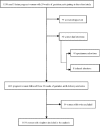Socioeconomic and Environmental Determinants to Preterm Birth in Tibetan Women: An Analysis Based on the Hierarchically Conceptual Frame
- PMID: 28937036
- PMCID: PMC5634080
- DOI: 10.4103/0366-6999.215341
Socioeconomic and Environmental Determinants to Preterm Birth in Tibetan Women: An Analysis Based on the Hierarchically Conceptual Frame
Abstract
Background: Preterm birth is a common cause of death in newborns and may result from many determinants, but evidence for the socioeconomic and environmental determinants of preterm birth in Tibetan women of childbearing age is limited. The aim of this study was to understand the current status of preterm birth in native Tibetan women and investigate the socioeconomic and environmental determinants.
Methods: Data were drawn from a cohort study which was conducted from August 2006 to August 2012 in rural Lhasa, Tibet, China. A total of 1419 Tibetan pregnant women were followed from 20 weeks' gestation until delivery; the loss to follow-up rate was 4.69%. The incidence of preterm birth was estimated to show the status of preterm births in Tibet. Logistic regression models for longitudinal data were established, and odds ratios (ORs) together with 95% confidence intervals (CIs) were used to evaluate the association between the occurrence of preterm birth and 16 selected potential determinants based on the hierarchical conceptual frame.
Results: The incidence of preterm birth was 4.58% (95% CI = 3.55-5.80%). After adjusting for health-related variables of the mothers and newborns, socioeconomic and environmental determinants associated with preterm birth included season (spring: OR = 0.28, 95% CI = 0.09-0.84; autumn: OR = 0.21, 95% CI = 0.06-0.69; and winter: OR = 0.31, 95% CI = 0.12-0.82) and calendar year of delivery (2010: OR = 5.03, 95% CI = 1.24-20.35; 2009: OR = 6.62, 95% CI = 1.75-25.10; and 2007-2008: OR = 5.93, 95% CI = 1.47-23.90).
Conclusions: The incidence of preterm birth among native Tibetan women was low and there was a decreasing trend in recent years; however, it is still essential to strengthen seasonal maternal care, extend the spacing between pregnancies, and reinforce adequate maternal nutrition.
Conflict of interest statement
There are no conflicts of interest.
Figures



Similar articles
-
Assessment of Seasonality and Extremely Preterm Birth in Denmark.JAMA Netw Open. 2022 Feb 1;5(2):e2145800. doi: 10.1001/jamanetworkopen.2021.45800. JAMA Netw Open. 2022. PMID: 35113166 Free PMC article.
-
Maternal and perinatal outcomes of pregnant women with SARS-CoV-2 infection at the time of birth in England: national cohort study.Am J Obstet Gynecol. 2021 Nov;225(5):522.e1-522.e11. doi: 10.1016/j.ajog.2021.05.016. Epub 2021 May 20. Am J Obstet Gynecol. 2021. PMID: 34023315 Free PMC article.
-
Determinants of low birthweight, small-for-gestational-age and preterm birth in Lombok, Indonesia: analyses of the birthweight cohort of the SUMMIT trial.Trop Med Int Health. 2012 Aug;17(8):938-50. doi: 10.1111/j.1365-3156.2012.03039.x. Trop Med Int Health. 2012. PMID: 22943372 Clinical Trial.
-
Reductions in stillbirths and preterm birth in COVID-19-vaccinated women: a multicenter cohort study of vaccination uptake and perinatal outcomes.Am J Obstet Gynecol. 2023 May;228(5):585.e1-585.e16. doi: 10.1016/j.ajog.2022.10.040. Epub 2022 Nov 3. Am J Obstet Gynecol. 2023. PMID: 36336084 Free PMC article.
-
Maternal genitourinary infections and poor nutritional status increase risk of preterm birth in Gasabo District, Rwanda: a prospective, longitudinal, cohort study.BMC Pregnancy Childbirth. 2020 Jun 3;20(1):345. doi: 10.1186/s12884-020-03037-0. BMC Pregnancy Childbirth. 2020. PMID: 32493304 Free PMC article.
Cited by
-
Incidence and trend of preterm birth in China, 1990-2016: a systematic review and meta-analysis.BMJ Open. 2020 Dec 12;10(12):e039303. doi: 10.1136/bmjopen-2020-039303. BMJ Open. 2020. PMID: 33310797 Free PMC article.
References
-
- Consonni S, Mainini V, Pizzardi A, Gianazza E, Chinello C, Locatelli A, et al. Non-invasively collected amniotic fluid as a source of possible biomarkers for premature rupture of membranes investigated by proteomic approach. Arch Gynecol Obstet. 2014;289:299–306. doi: 10.1007/s00404-013-2967-9. - PubMed
-
- Sandeva M, Uchikova E. Frequency and medical social aspects premature birth (in Bulgarian) Akush Ginekol (Sofiia) 2016;55:27–33. - PubMed
-
- Kurek Eken M, Tüten A, Özkaya E, Karatekin G, Karateke A. Major determinants of survival and length of stay in the neonatal Intensive Care Unit of newborns from women with premature preterm rupture of membranes. J Matern Fetal Neonatal Med. 2017;30:1972–5. doi: 10.080/14767058.2016.1235696. - PubMed
MeSH terms
LinkOut - more resources
Full Text Sources

